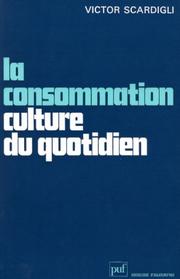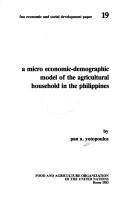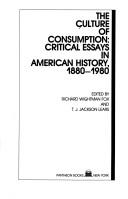| Listing 1 - 10 of 23 | << page >> |
Sort by
|
Book
ISBN: 2903449082 Year: 1983 Publisher: Aix-en-Provence : Librairie de l'Université,
Abstract | Keywords | Export | Availability | Bookmark
 Loading...
Loading...Choose an application
- Reference Manager
- EndNote
- RefWorks (Direct export to RefWorks)
Book
Year: 1983 Publisher: Cambridge, Mass. National Bureau of Economic Research
Abstract | Keywords | Export | Availability | Bookmark
 Loading...
Loading...Choose an application
- Reference Manager
- EndNote
- RefWorks (Direct export to RefWorks)
One important channel through which real interest rates affect aggregate demand is consumer expenditure on durable goods. This paper examines empirically the link between interest rates and consumer durables. Solving for the decision rule relating income and interest rates to consumer demand is an intractable task. This paper avoids this problem by examining the first-order conditions necessary for maximization by the representative consumer. Structural parameters of there presentative utility function are thus recovered. The estimated model suggests that expenditure on consumer durables is far more sensitive to changes in the interest rate than is expenditure on nondurables and services.
Interest rates --- Consumption (Economics) --- Mathematical models.
Book
Year: 1983 Publisher: Cambridge, Mass. National Bureau of Economic Research
Abstract | Keywords | Export | Availability | Bookmark
 Loading...
Loading...Choose an application
- Reference Manager
- EndNote
- RefWorks (Direct export to RefWorks)
Using panel data for a sample of households in Utah from 1850 to 1900 we find income and wealth age profiles that are concave and that have a peak within the age distribution of the relevant sample. This finding holds for cross sections at five-year intervals, for pooled cross section time-series data, for cohort data, for households when individual differences are accounted for with a variance-components model and when we account for vintage measured as duration within the economy.We also find a relationship between age-income and age-wealth profiles that is consistent with a life-cycle model of consumption given a concave and peaked age-income profile: households accumulate and then begin to draw down wealth holdings, the age-wealth profile consistently peaks at an age later than the age-income profile for the same households, and the age-wealth profile for young households is considerably steeper than is the age-income profile.We have data, then, that in many respects appear to be capable of having been generated by individual decisions in a contemporary economy.This is particularly interesting since the data were, in fact, generated within a very different economy, one where formal education, on-the-job training and labor-leisure choices were probably considerably less important than in a contemporary economy.
Wealth. --- Income distribution. --- Saving and investment. --- Consumption (Economics)

ISBN: 2130378587 9782130378587 Year: 1983 Publisher: Paris: PUF,
Abstract | Keywords | Export | Availability | Bookmark
 Loading...
Loading...Choose an application
- Reference Manager
- EndNote
- RefWorks (Direct export to RefWorks)
Consumption (Economics) --- Quality of Life --- Technology and civilization --- Consumption (Economics). --- Quality of life. --- Technology and civilization. --- Modernité --- Consumerisme --- Culture de masse
Book
Year: 1983 Publisher: Malmö : Infotryck,
Abstract | Keywords | Export | Availability | Bookmark
 Loading...
Loading...Choose an application
- Reference Manager
- EndNote
- RefWorks (Direct export to RefWorks)
Consumptiepatroon. --- Consumption (Economics) --- Consumption (Economics). --- Credit --- Credit. --- Crédit. Consommation. --- Crédit. Controle de l'Etat. Consommation. --- Huishoudingen. --- Kredietverlening. --- Ménage. Consommation. Crédit. Controle. --- Sparen. --- Sweden.

ISBN: 9251013691 Year: 1983 Publisher: Rome FAO
Abstract | Keywords | Export | Availability | Bookmark
 Loading...
Loading...Choose an application
- Reference Manager
- EndNote
- RefWorks (Direct export to RefWorks)
Agricultural laborers --- Agricultural wages --- Consumption (Economics) --- Demographic surveys --- Rural families --- Philippines --- Population --- Mathematical models.

ISBN: 0394716116 9780394716114 Year: 1983 Publisher: New York: Pantheon books,
Abstract | Keywords | Export | Availability | Bookmark
 Loading...
Loading...Choose an application
- Reference Manager
- EndNote
- RefWorks (Direct export to RefWorks)
History of North America --- Sociology of culture --- anno 1800-1999 --- United States --- Consumption (Economics) --- Elite (Social sciences) --- Social values --- History --- Consumption (Economics) - United States - History --- Elite (Social sciences) - United States - History --- Social values - History --- United States of America

ISBN: 2213012431 9782213012438 Year: 1983 Publisher: Paris: Fayard,
Abstract | Keywords | Export | Availability | Bookmark
 Loading...
Loading...Choose an application
- Reference Manager
- EndNote
- RefWorks (Direct export to RefWorks)
Collective behavior --- Consumption (Economics) --- Political participation --- Self-interest --- Comportement collectif --- Consommation (Economie politique) --- Participation politique --- Intérêt personnel --- 304 --- sociologie --- Intérêt personnel --- CDL --- 316 --- Comportements politiques --- Systemes de valeurs
Book
ISBN: 2070353168 Year: 1983 Publisher: Paris Gallimard
Abstract | Keywords | Export | Availability | Bookmark
 Loading...
Loading...Choose an application
- Reference Manager
- EndNote
- RefWorks (Direct export to RefWorks)
Civilization, modern. --- Consumers. --- Consumption (Economics) --- History. --- National consumption --- 316.323.65 --- 658.8 --- 658.8 Marketing. Sales. Selling. Distribution --- Marketing. Sales. Selling. Distribution --- 316.323.65 Verzorgingsstaat. Welvaartsstaat --- Verzorgingsstaat. Welvaartsstaat --- Sociology of culture
Book
ISBN: 2709906716 9782709906715 Year: 1983 Volume: 57 Publisher: Paris: ORSTOM,
Abstract | Keywords | Export | Availability | Bookmark
 Loading...
Loading...Choose an application
- Reference Manager
- EndNote
- RefWorks (Direct export to RefWorks)
Sociology of environment --- Economic sociology --- Burkina Faso --- Consumption (Economics) --- Mossi (African people) --- -Cost and standard of living --- -Economic conditions --- -Mossi (African people) --- -Moaaga (African people) --- Mole (African people) --- Mooré (African people) --- Moose (African people) --- Moré (African people) --- Moshi (African people) --- Mosi (African people) --- Mossé (African people) --- Ethnology --- Comfort, Standard of --- Cost of living --- Food, Cost of --- Household expenses --- Living, Cost of --- Living, Standard of --- Standard of living --- Home economics --- Households --- Quality of life --- Wealth --- Luxury --- Prices --- Purchasing power --- Wages --- Consumer demand --- Consumer spending --- Consumerism --- Spending, Consumer --- Demand (Economic theory) --- Economic conditions --- Surveys --- Cost and standard of living --- Moaaga (African people) --- Sociologie van het leefmilieu --- Sociologie van de economie --- Consumption (Economics) - Burkina Faso --- Mossi (African people) - - Economic conditions --- Cost and standard of living - - Burkina Faso --- Moaga (African people) --- -Sociology of environment --- -Consumption (Economics) --- -Cost and standard of living -
| Listing 1 - 10 of 23 | << page >> |
Sort by
|

 Search
Search Feedback
Feedback About UniCat
About UniCat  Help
Help News
News